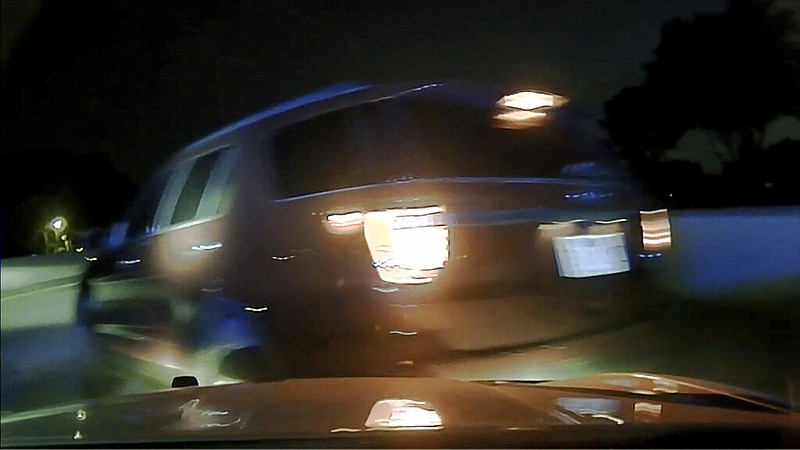A legal settlement prompted the Arkansas State Police to adjust its policy on precision immobilization technique (PIT) maneuvers, but the agency insists that the tactic is an important tool in ending pursuits, and data shows that it has been used more frequently in recent years.
Between 2016 and 2020, use of the tactic -- which involves a trooper driving a patrol vehicle to strike the rear side of a fleeing car, causing it to spin out of control -- has increased every year, according to data provided by state police.
Since 2018, at least one in four pursuits has ended with a PIT maneuver.
In 2018 and 2019, about 28% of pursuits ended with PIT maneuvers. In 2020, the number rose to about 32%, and as of Oct. 30 of this year, about 25% of pursuits ended that way.
State police pin the rise in use of the technique on an increase in criminal pursuits, dangerous driving and general lawlessness.
On Friday, state police reached a preliminary settlement with Janice Nicole Harper, who was traveling on U.S. 67/167 in Pulaski County on July 9, 2020, when state Trooper Rodney K. Dunn attempted to stop her vehicle for speeding, according to a release from law firm Denton and Zachary PLLC, which represents Harper.
Footage shows Harper turning on her vehicle's hazard lights and looking for a safe place to pull over on the strip of highway that was lined with concrete barriers, the release states.
The incident ended a few minutes later when Dunn used a PIT maneuver that caused Harper's car to flip over, according to accounts.
Because of the settlement, state police clarified their use-of-force policy to instruct troopers to judge whether using the technique is "objectively reasonable," Arkansas State Police spokesman Bill Sadler said.
Proponents of the tactic contend that it saves lives by stopping pursuits that are endangering the public, but the technique can also claim lives.
One person died in 2019, three died in 2020 and two died by the end of October this year, Sadler said. He could not provide data on injuries resulting from the tactic, but said if there is any indication that a person is hurt in the course of ending a pursuit, the person is taken for medical treatment.
The number of PIT maneuvers has increased along with the number of pursuits, but the frequency of PIT use also reflects more severe crime on the roads, Sadler said.
"[The] degree of lawlessness is increasing, which ultimately leads to the trooper having to make a decision about how to remove the threat to the public," Sadler said.
Arkansas State Police Col. Bill Bryant testified Nov. 10 before state lawmakers on the Game and Fish Commission and State Police Subcommittee, outlining the rise in aggressive driving and police pursuits, and defending the use of PIT maneuvers.
Since 2016, state police have seen a 98% increase in pursuits, with an 170% increase in Pulaski, Saline, Lonoke and Faulkner counties in the same period, Bryant said.
In 2020, there were 505 pursuits, up from 232 in 2016, according to state police data. As of Oct. 30, there had been 376 pursuits this year.
PIT maneuvers have "no doubt saved the lives of many Arkansans," Bryant said at the hearing, which occurred before the settlement was announced but well after state police internally concluded that Dunn had made a mistake.
Dunn, a 27-year state police veteran, was disciplined, but Sadler said he could not give details because the sanction did not rise to the level of suspension or termination.
The maneuver is not the only tactic troopers use to end pursuits, and they are permitted to end a pursuit if they determine that the risk of continuing it is greater than the need to catch the violator.
The ramming tactic is a "high-risk maneuver for everyone involved," state police Sgt. Coty Williams said during the hearing.
Also at the hearing, Arkansas Department of Public Safety chief legal counsel Cody Hiland defended troopers using measures that they see as needed to end pursuits.
"We can't handcuff them," Hiland said, referring to the officers. "They don't perform these PIT maneuvers to get their jollies."
Troopers have told Hiland that even in situations where their lives are at risk, they worry about getting "dinged" with a lawsuit or some other punishment because of the choice they make, he said.
State Sen. Ricky Hill, R-Cabot, chairman of the legislative subcommittee, said he supports state police "100%" in the use of PIT maneuvers.
"I trust you gentlemen and the calls you have to make," he said.
Hill, whose daughter is a state police officer in another state, hopes to see a turn from the "anti-police movement" that has fueled criticism of police use of force such as PIT maneuvers, he said.
Subcommittee member Rep. Jim Wooten, R-Beebe, a former Arkansas trooper, argued that the use of force by police is always a reaction, because the violator initiated the incident. Troopers don't need to be second-guessed on their decisions, he said.
Other than PIT maneuvers, troopers can also employ spike strips intended to flatten tires, stationary roadblocks or "rolling roadblocks" -- where several troopers box in a vehicle using their patrol vehicles -- or adhesive GPS tags that are fired from their vehicles using compressed air.
The last tactic, part of a pilot program called StarChase, has been primarily tested in Troop A, and uses a combination of adhesive and a magnet to attach a tracker to the fleeing vehicle, Bryant said. This tactic requires relatively close launching distances of about 30 feet, and the trackers don't always stick, he said, but troopers have liked having the tool.
